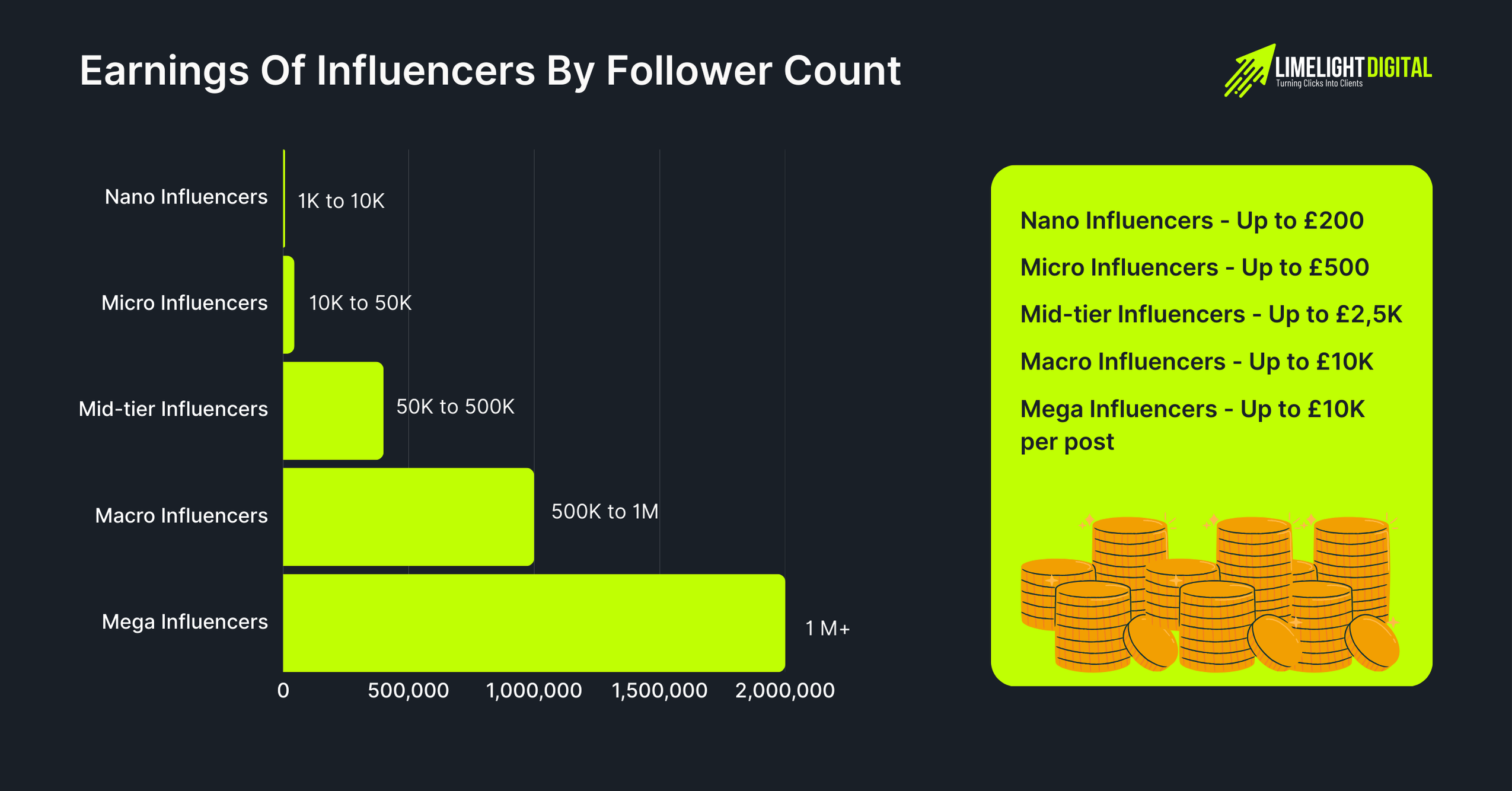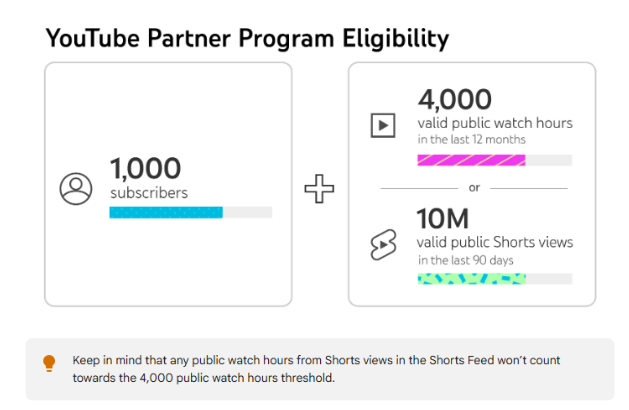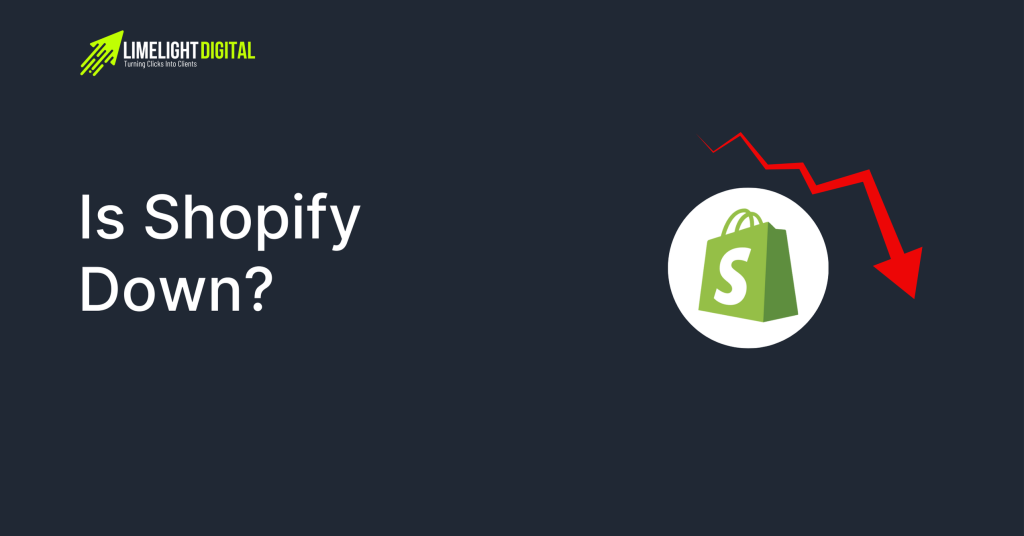According to Statista report, influencers with 2 or 3 years experience can earn around £33.5K annually on various social media platforms.
But how much do influencers in the UK actually make? Is it enough to replace a full-time job, or is it just side hustle money? The answer isn’t as simple as you might think, as income varies based on follower count, engagement, platform, and niche.
In this article, we’ll break down influencer earnings in the UK, explaining who’s making what and how.
Different Types of Influencers & Their Earning Potential
The earnings of every influencer are not the same or fixed. It can vary depending on the number of followers and engagement rate.

Here’s an estimate of the earnings of influencers based on their number of followers.
| Influencer Type | No. of Followers | Earnings |
|---|---|---|
| Nano Influencers | 1K to 10K | Up to £200 |
| Micro Influencers | 10K to 50K | Up to £500 |
| Mid-tier Influencers | 50K to 500K | Up to £2,5K |
| Macro Influencers | 500K to 1M | Up to £10K |
| Mega Influencers | 1M+ | Up to £10K per post |
Here’s a general breakdown of influencer categories and how much they typically earn:
1. Nano-Influencers (1,000 – 10,000 Followers)
These are everyday social media users who’ve built a small but engaged community. Since they don’t have massive reach, they don’t earn as much, but brands love working with them because their followers trust their recommendations.
Earnings: £50 – £200 per sponsored post
2. Micro-Influencers (10,000 – 50,000 Followers)
Micro-influencers are the sweet spot for brands—they have enough followers to be influential, but not so many that they seem out of touch. They tend to charge more than nano-influencers but still rely on multiple income streams.
Earnings: £100 – £500 per sponsored post
3. Mid-Tier Influencers (50,000 – 500,000 Followers)
This group starts making real money. They often work with bigger brands on long-term deals and may even have their own product lines.
Earnings: £500 – £2,500 per sponsored post
4. Macro-Influencers (500,000 – 1 Million Followers)
Now we’re in serious money territory. These influencers usually have management teams and negotiate large deals with well-known brands. They can afford to be selective with partnerships.
Earnings: £2,500 – £10,000 per sponsored post
5. Mega-Influencers (1 Million+ Followers)
Think celebrities and internet sensations. They charge massive fees for a single post and may even have brand collaborations of their own.
Earnings: £10,000+ per sponsored post
What Affects Influencer Earnings?
Not all influencers earn the same, even if they have similar follower counts. Many factors determine how much money an influencer can make. Here are some of the biggest ones:
1. Follower Count vs. Engagement Rate
Having millions of followers doesn’t always mean big earnings. Brands prefer influencers who have high engagement rates—likes, comments, shares, and saves—rather than just a large audience.
A micro-influencer with 20,000 highly engaged followers might earn more per post than a celebrity with a million disengaged followers.
To boost earnings, influencers should focus on building trust and engagement with their audience, not just increasing their follower count.
2. Content Niche
Some niches are simply more profitable than others. For example:
- Finance, business, and tech influencers earn more because their audience includes high-income professionals.
- Fashion, beauty, and fitness influencers attract brands willing to spend on marketing.
- Lifestyle and travel influencers get free products and experiences but may earn less in direct payments.
3. Platform Choice
Some platforms are more lucrative than others. YouTube and Instagram typically pay influencers more through ads and sponsorships, while TikTok and Twitter (X) have lower earning potential unless an influencer has viral content.
4. Location & Audience Demographics
Where an influencer is based—and who their followers are—affects how much they can charge. Brands pay more for UK- and US-based influencers because audiences in these countries have higher purchasing power.
For Example: A UK influencer with 100,000 followers might earn £500 per post, while an influencer with the same number of followers in a lower-income country might earn £100 per post.
5. Brand Relationships & Negotiation Skills
Some influencers earn more simply because they know how to negotiate. Those who build long-term relationships with brands often secure higher-paying, ongoing contracts instead of one-off deals.
Influencers who understand their worth and aren’t afraid to negotiate tend to earn significantly more over time.
How Much Do Influencers Make on Different Platforms?
While Instagram is the go-to platform for influencer marketing, YouTube, TikTok, and even Twitter (X) also offer lucrative opportunities.

Here’s how earnings compare across platforms:
| Platform | Ideal Followers/Subscribers to Start Earning | Earnings Per Post (£) |
|---|---|---|
| 10,000+ (Micro-Influencers) | £100 – £500 | |
| YouTube | 50,000+ (Mid-Tier Influencers) | £750 – £7,500 (per video) |
| TikTok | 100,000+ | £100 – £750 |
| Twitter (X) | 100,000+ | £15 – £75 |
| 500,000+ | £9,375 – £18,750 |
How Much Does Instagram Influencers Make?
Instagram remains the most popular influencer platform. UK micro-influencers (10,000 – 50,000 followers) typically make £100 – £500 per post, while those with over a million followers can command £10,000+ per post.
How Much YouTube Influencers Earn?
Since YouTube offers ad revenue in addition to sponsorships, influencers can earn a steady income. A YouTuber with 100,000 subscribers can make £750 – £7,500 per video, depending on views and ad engagement.
How Much Do TikTok Influencers Make?
TikTok influencers make less per post than Instagram but can still earn decent money. A TikToker with 500,000+ followers may earn between £225 – £750 per sponsored post. However, viral videos can bring in more cash through the TikTok Creator Fund.
Twitter (X) & Facebook Influencer Earnings
These platforms don’t pay as well as Instagram or YouTube, but macro-influencers (500,000+ followers) can still make between £15 – £75 per post on Twitter and £9,375 – £18,750 per post on Facebook.
How Influencers Make Money (Beyond Sponsored Posts)
While brand deals are a major source of income, influencers don’t rely solely on them. Many create multiple income streams to build a more stable financial future.

Here are some of the most common ones:
1. Affiliate Marketing
Instead of being paid upfront, influencers earn commissions when their followers buy products through unique affiliate links. Fashion and beauty influencers, for example, often use programs like RewardStyle (LIKEtoKNOW.it) or Amazon Associates to monetize their recommendations.

Potential Earnings: A micro-influencer might make £100-£1,000 per month, while a macro-influencer can earn £5,000+ monthly if they have a strong, engaged audience.
2. YouTube Ad Revenue
YouTube pays influencers based on ad views through Google AdSense. A video with 100,000 views could earn anywhere from £250 to £1,000, depending on the content’s niche and the audience’s location. You can find more details on how YouTube ad revenue works in this guide on YouTube monetization.

Potential Earnings: A YouTuber with 1 million subscribers can make anywhere from £3,000 to £40,000 per month from ads alone, depending on their video views.
3. Selling Their Own Products
Many influencers launch their own products or brands. Beauty influencers might create skincare or makeup lines, fitness influencers sell workout plans or supplements, and gamers design merchandise.
Potential Earnings: This varies widely—some influencers make a few hundred pounds a month, while others, like Molly-Mae Hague with her PrettyLittleThing collaboration, rake in millions.
4. Memberships & Exclusive Content
Some influencers use Patreon, OnlyFans, or YouTube Memberships to offer exclusive content to fans in exchange for a monthly subscription fee.
Potential Earnings: Even a small, dedicated audience can generate £1,000+ per month through memberships.
5. Public Speaking & Event Appearances
Popular influencers are often invited to speak at events, host workshops, or attend brand launches, where they’re paid to make appearances.
Potential Earnings: Speaking fees range from £500 to £10,000+ per event, depending on the influencer’s niche and popularity.
Challenges Of Being An Influencer
While the idea of getting paid to post on social media sounds amazing, it’s not all glamorous. Being an influencer comes with its own set of struggles:
1. Unstable Income
Unlike a traditional job, influencer earnings can fluctuate. One month might bring in £5,000, while the next month only £500. Many influencers take side jobs or diversify their income streams to stay financially secure.
2. High Competition & Market Saturation
There are millions of influencers out there, making it harder to stand out. The more influencers in a niche, the more brands can negotiate lower rates.
3. Mental Health Pressure
Maintaining an online presence 24/7 can be exhausting. Many influencers experience burnout, online hate, and anxiety from constantly being in the public eye.
4. Dependence On Algorithms
Social media platforms frequently change their algorithms. An influencer who once had high engagement might suddenly see a drop in likes and views, affecting their earnings.
5. Workload Misconceptions
People assume influencers just “snap a picture and get paid,” but the reality is different. A single sponsored post involves:
- Planning & shooting content
- Editing & revisions
- Writing captions
- Negotiating contracts
- Engaging with followers
- Meeting brand deadlines
It’s essentially running a business, and many influencers work longer hours than a regular 9-to-5 job.
Is Being An Influencer A Sustainable Career?
For some, yes. Many influencers build brands, launch businesses, and invest their earnings to create long-term financial stability. However, for most, influencer marketing is more of a side hustle than a full-time career.
If you’re considering becoming an influencer, focus on engagement over follower count and diversify your income so you’re not dependent on brand deals alone.
More Suggested Reads:
Conclusion: Influencers Can Earn Up To £10,000 Per Month
The world of influencer marketing is exciting, but it’s not as effortless as it may seem. While some influencers in the UK make thousands per post, many struggle to secure consistent income. The key to success isn’t just about having a huge following—it’s about engagement, niche expertise, and smart monetization strategies. Those who diversify their income through brand deals, affiliate marketing, YouTube ads, and their own products stand a better chance of turning influencing into a full-time career.
That said, it’s important to recognize the challenges—algorithm changes, mental health pressures, and unpredictable earnings—that come with the job. For some, influencing is a dream career, while for others, it works better as a side hustle. If you’re considering becoming an influencer, focus on building a loyal audience, creating high-quality content, and exploring multiple income streams to ensure long-term success.






